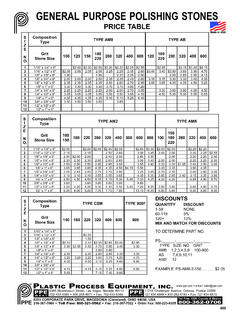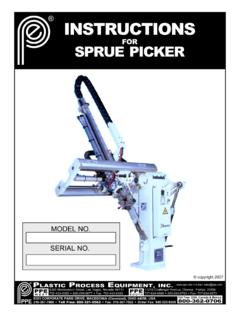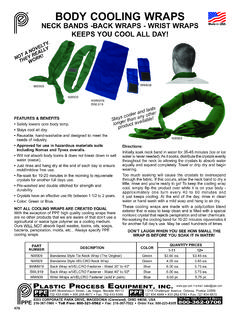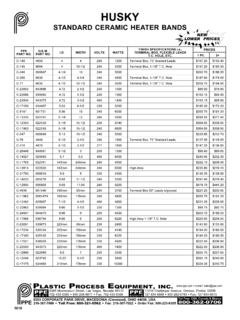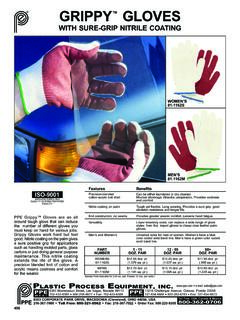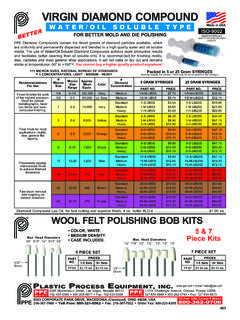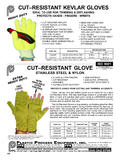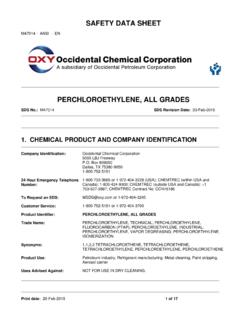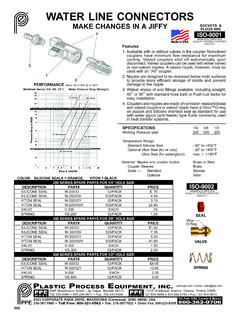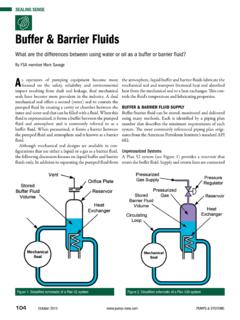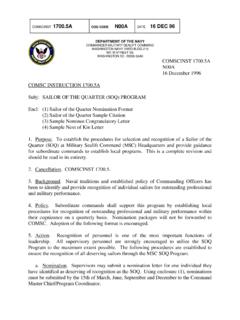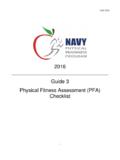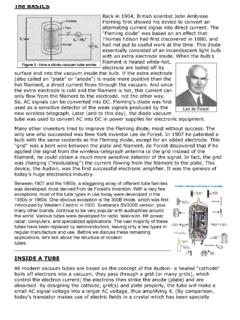Transcription of TIE BAR STRAIN AGE INSTRUCTION MANUAL - PPE
1 TIE BAR STRAIN GAGEINSTRUCTION MANUALPLASTIC PROCESS EQUIPMENT, CORPORATE PARK DRIVEMACEDONIA, OHIO 44056 PHONE: 216-367-7000 FAX: 216-367-7022 TABLE OF CONTENTSS afety tie gage to D and DS Tie Bar (one piece)..6 Model DA and DSA Tie Bar (two-piece)..7 Zero the procedure for all tie and store tie bar pressure for which machine was readings to determine tonnage of one tie total machine Table total machine target dial gage use and 1 - Gage 2 - Parts , 18 Figure 3 - Approximate , 20 TablesTable 1 - Approximate 3 SAFETY INSTRUCTIONSThis MANUAL uses the following words to show different levels of danger:DANGER indicates an imminently hazardous situation which, if not avoided, will result in death orserious indicates a potentially hazardous situation which, if not avoided, could result in death orserious indicates a potentially hazardous situation which, if not avoided, may result in minor ormoderate injury and/or property following is a general warning that applies when using the Tie Bar STRAIN Gage.
2 WARNINGMACHINERY can cause DEATH or INJURYU sing this tie bar STRAIN gage may involve being very close to a die casting machine clampwhile the machine is moving. Die casting machine clamps are capable of very fast,extremely powerful movements that could kill you or severely injure machine's safety procedures when using machine's safety devices before using gage. Do not defeat or bypass machine's guards or interlockswhen using gages. Only qualified technicians are touse this gage. Use gage only if it can be usedsafely on your machine. Page 4 PPE TIE BAR STRAIN GAGEThe PPE Tie Bar STRAIN Gage directly monitors the amount of stretch in a tie bar understrain. An amplifying arm proportions the stretch onto a dial indicator, yielding a strainreading. By relating the STRAIN reading to the diameter of the tie bar, you can determine theactual STRAIN level on that tie measurement of STRAIN on the four tie bars can be used two ways:!
3 To determine if there is equal locking pressure on all four tie bars! To determine the actual tonnage the press is generating at lockupThe information acquired by using the Tie Bar STRAIN Gage will help you obtain maximum,uniform press clamping pressure without overloading toggles or tie bars. Using this uniqueinstrument will help to eliminate costly and unnecessary breakage while verifying the actualtonnage your press is delivering. The PPE Tie Bar STRAIN Gage also comes in aspecial two-gage package that allows you to check both sides of your press at the sametime. For information concerning the special two-gage package or for questions about theTie Bar STRAIN Gage, contact a PPE Customer Service Representative at : instructions ARE EASIEST TO UNDERSTAND IF YOU REFER TO THEPARTS IDENTIFICATION FIGURE ON PAGE 17 and :This gage has been designed for machines in which there is 10,000 psi ofpressure on each tie bar at full locking tonnage.
4 Most injection presses fallinto this category. Because the gage starts with a measurement of tie bar stretch, abnormallysized tie bars or abnormal machine designs could produce different using the readings from this gage in a calculation of tonnage,determine the tie bar pressure for which your machine was designed. Theequation for that determination is on page 5 TAKING Tie a gauging position on each tie the following criteria to select a location:(1)14" run of tie bar needed for a 12" gage, or 9" run needed for an 8" : The 12" gage is easier to align than the 8" gage, and is slightly moreaccurate. Use the 12" gage if possible. In addition to the difference inlength, there is a different bevel angle on the magnetic bases. The bevels onthe larger gage may not fit the radius of bars less than 2" in diameter. Thesmaller gage may not fit bars larger than 6" in diameter.
5 (2)Gage should not be in way of any moving machine parts.(3)If possible, locate behind moving platen, but not on tie bar it is necessary to take readings in front of moving platen, take a reading onboth the inward and outward sides of tie bar. Average the two readings. This averaging will compensate for possible tie bar bending caused by thestationary platen bowing during lockup.(4)If possible, use the top side of the bottom tie bars and the bottom sideof the top tie bars. See figure 1 on page area on tie bar. Remove any dirt. Dirt could prevent the housings frombeing centered on the bar, therefore preventing accurate measurements. Leave a thin film of oil or : If using this gage on chrome plated tie bars, you will need to use a special set of clamps (available from PPE) to attach gage to tie bar. Need additional information? Please call 6 Figure 1 Proper Combinations of Gage Gage on Bar (ONE-PIECE STRAIN GAGE)The item numbers in Parentheses in the following procedure refer to Figure 2 onpage the actuator rod lock (figure 2, item 6) clockwise to tighten it.
6 This willkeep the magnetic bases aligned while the gage is being installed on thebar. the clamp is open and hydraulic power is locked out to the clamp, holdthe gage on the bar. Turn the magnet control lever (figure 2, item 1) on the indicator housing base(B) to the ON position. the indicator housing base until it is holding very firmly and is parallelwith the tie bar. the actuator rod lock (figure 2, item 6).Hold the bases far enough apart that the dial indicator reaches the end of itstravel. It should stop at about 2 - 1/2 7 Turn the zero-setting lever (3) to the 10 o'clock position (as viewed acrossthe dial). Press the magnetic bases as close together as possible. Tightenthe actuator rod lock. The dial indicator should read 9 + 3 divisions. If itdoes not, adjust the actuator rod according to the instructions on page the magnet control lever on the actuator rod base (A) to the ON the actuator rod lock.
7 Move the zero-setting lever clockwise (asviewed across the dial) making sure the dial indicator goes past the 0 markby the time the zero-setting lever reaches the one o'clock position. Makesure you can reach 2 on the indicator. If not, adjust the length of the actuatorrod according to instructions on page squarely on the far side of the actuator rod base while moving the zerosetting lever, until there is little drag on the zero setting lever. There shouldbe some resistance (to prevent backlash), but the movement should not will indicate that the bases are aligned (with the actuator rod slidingthrough the bore in the indicator housing without resistance).Try to wiggle the base. The base and needle should not Gage on Bar (TWO-PIECE STRAIN GAGE)The item numbers in parentheses in the following procedure refer to Figure 2 onpage the magnet base containing the indicator (B) on the bar with theindicator on the left side.
8 Turn the magnet handle (1) on the and insure thebase is seated on the tie bar and locked down by trying to move the magnet base (A), with the zeroing lever (3) in the 10 o'clockposition, against the actuator rod (5) of the first magnet. Push towardindicator until indicator long hand reads between 7 & 9, short hand on 0. Turn the magnet handle (1) on and insure that base is seated on the tie barand locked down by trying to move the zeroing lever (3) away from you. It should start to move by the timeyou reach the far corner of the the long hand on "0". Gently try to move each magnet. You should notget a movement of the the the zero-setting lever (3) back and forth. Check for light resistance. Redo steps (d) through (g) in the One-Piece instructions if there is more thanlight the zero-setting lever until the indicator needle is pointing to the safety gates. Enable machine 2 or 3 cycles.
9 The vibration of the machine while it is cycling willhelp to seat the machine's MANUAL mode and a slow clamp speed to inch clamp into fullylocked machine. Open safety Dial indicator. Record safety gates. Enable machine. Open clamp just enough to part machine. Open safety Gage, It should read 0 + 3 divisions. If it does not return to 0 + 3divisions, magnets are slipping on tie bar. Make sure tie bar and magnetsare clean and free of steps a through h. You should obtain the same (One Piece Only) Lock the actuator rod lock. Unlock magnetic bases andremove :The first time you use gage on any particular machine, take readingsfrom various places on the bar. Find locations that give the mostrepeatable gaging procedure for all four-tie and store gage off tie bars, turn magnetic locking levers OFF and store gage in thewooden box in which it was shipped. Keep boxed gage in a dry area, protectedfrom extreme TIE BAR PRESSURE FOR WHICH YOURMACHINE WAS DESIGNEDP=Fyy/areayywhere:P = pressure expected on tie rod at full lockup {psi}Fyy = total rated force {lbs}{= total rated tonnage x 2000lbs} areayy = 4 x x (D/2)5 {sq in}{D= diameter of one tie bar} If P does not equal 10,000 psi, divide P by 10, any equation in the MANUAL calls for an actual reading (R), multiply the reading byP/10,000 first.
10 Do not multiply Ryy by P/10,000, :100-ton press with " diameter tie = 100 x 2000 / 4 x x ( )5 = 200,000 / = 10,19110,191 / 10,000 = shock and vibration can knockgage out of not leave gage on tie bar when youare not using locking levers in ON positionwill wear out not leave locking levers in ONpositionPage 10 USING READINGS TO DETERMINE first step in using readings is to determine tie bar pressure for which yourmachine was designed. Use the equation on page 9. For machines not set up for10,000 psi at full lock-up, all tonnage figures must be readings and equations in one or more of the following find tonnage of one tie bar (see below) approximate machine tonnage (without using math, see page 11 forgraph method and table method) compute machine tonnage (see page 12)FINDING TONNAGE OF ONE TIE BARThe formula for finding the tonnage of one tie bar is:T = STRAIN x areaT = R/2 x pi x (D/2)55where:T =tonnageR =dial reading at lockupD =diameter of tie rod (in inches)Take pi to 2 places.
